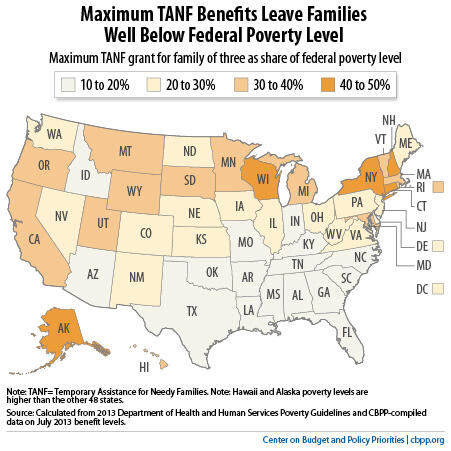BEYOND THE NUMBERS
Cash assistance benefits for the nation’s poorest families with children fell again in purchasing power in 2013, we explain in our annual update of state benefits under the Temporary Assistance for Needy Families (TANF) program. Seven states increased TANF grant amounts last year — and encouragingly, no state cut benefits — but most kept family grant levels unchanged, allowing inflation to continue eroding the benefits’ value.
TANF is often the only source of support for participating families and, without it, they would have no cash income to meet their basic needs. Yet, this critical safety net program supports fewer families — and its benefits are worth less — than ever before. Consider:
- In 2012, just 25 of every 100 poor families received TANF benefits, down from 68 of every 100 in 1996, the year policymakers created TANF to replace the former Aid to Families with Dependent Children program.
- TANF benefit levels are at least 20 percent below their 1996 levels in 37 states, after adjusting for inflation.
- As of July 1, 2013, every state’s benefits for a family of three with no other cash income were below 50 percent of the federal poverty line, measured by the Department of Health and Human Services 2013 poverty guidelines (see map). Benefits were below 30 percent of the poverty line in most states.

A few of the states that increased TANF benefits in 2013 were following through on past commitments to modestly raise benefits or adjust them for inflation. Three states — Connecticut, Ohio, and Wyoming — increased TANF benefits through annual cost-of-living adjustments (COLAs). Such an automatic mechanism, built into state law, is the best way to prevent the value of TANF benefits from falling and to keep them even with inflation.
These are promising steps, but still more states should consider similar policy changes. It’s time for states to halt the erosion of TANF benefits and slowly restore some of the purchasing power the grants have lost over the past 17 years.
Click here for the full paper and 50-state data.
